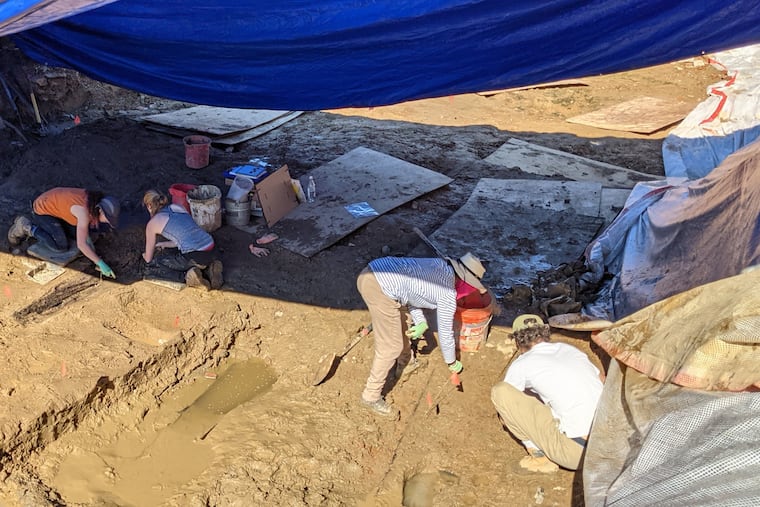Human remains from nearly 200-year-old cemetery discovered under Northern Liberties strip-mall parking lot
Beginning in 1832, the site was home to the Fifth Street Methodist Episcopal Church and a small cemetery where church members were laid to rest.

Human remains from a nearly two-century-old cemetery have been discovered under a strip-mall parking lot in Northern Liberties, adding to the long list of Philadelphia’s historic, unknown grave sites unearthed during construction.
For more than 50 years, the strip mall at Fifth and Spring Garden Streets has seen a rotation of businesses, most recently a beer store, nail spa, and Dollar General.
But beginning in 1832, the site was home to the Fifth Street Methodist Episcopal Church, and a small cemetery where church members were laid to rest, historic maps and Inquirer archives show. The cemetery was disinterred in the late 1800s, experts say, but some of the graves were missed, remaining hidden and forgotten beneath the pavement.
In May, father-and-son development team Neal and Victor Rodin — who also own the high-end complex home to the Whole Foods near the Philadelphia Museum of Art — purchased 501-39 Spring Garden St. with a plan to build a mixed-use building featuring apartments, retail space, and an underground parking garage.
The developers retained archaeologists from the New-York based environmental planning firm AKRF Inc. to research the history of the site in February, before beginning construction.
According to a summary of AKRF’s work provided to the Philadelphia Archaeological Forum and reviewed by The Inquirer, historic records showed that the church disinterred burials from the grave site in the 1860s and 1870s, before residences were developed on top. A gas station was later built, and then the mall, the report says.
The developers had AKRF and contractors test multiple sites in the property, and a 60-by-30-foot area in the parking lot was identified as potentially holding a few remaining graves. The firm excavated the space, and a team of seven archaeologists hand-sifted through the gravel before encountering a series of old coffins.
The document says that most burials encountered had been destroyed by past development or previously relocated, but “a small number of burials” — likely missed during the previous relocations — contained “disarticulated human remains.”
The developers did not seek the required court permission before having the team of archaeologists excavate and transport the remains, but said they did not believe they had to. They planned to petition the courts after completing the recovery and connecting with the descendant church, to get approval for reburial.
The remains were “documented, excavated, and transferred to the forensics laboratory located at Rutgers University’s Camden campus for storage in an appropriate, climate-controlled environment,” the AKRF document says. A Rutgers osteologist, or bone scientist, is examining the remains “in a nondestructive manner” to identify the individuals’ demographics.
In a statement, the Rodins’ development company, RREI LLC, said it engaged with the archaeology firm to ensure the respectful and careful inspection and removal of the items since learning of the cemetery.
In a city as old as Philadelphia, encountering forgotten cemeteries during construction is not unusual.
“Cemeteries are hit in Philadelphia about once every year and a half,” said Doug Mooney, president of Philadelphia Archaeological Forum, which runs a website that maps more than 300 current and former marked and unmarked cemeteries in the city.
Once the owners of the land discover the presence of remains, Mooney said, state law requires them to petition the Philadelphia Orphans’ Court, which has jurisdiction over all unidentified remains, to get permission to exhume and recover any remains, and then have them relocated and reburied.
“We thought the best practice would be to engage a full team of archaeologists to carefully document and remove the remains to a safer location, as opposed to it being out in the open once we exposed the extent of the cemetery,” said developer Victor Rodin. “We were advised that there was no rule that we had to engage the Orphans’ Court right now.”
Mooney said that state law and court precedent clearly require it, but Philadelphia does not have its own ordinance requiring it, so agencies do not always enforce the state law.
Mark Zecca, who represented the Philadelphia Historical Commission for many years during his 20-year tenure in the city Law Department, said that it is encouraging to hear the developer took early action to identify remains, but that the appropriate legal steps must still be followed.
“You don’t own the remains, they are human beings, they’re not property, they’re not dirt,” said Zecca. “Just because they’re in your ground doesn’t mean you own them.”
Zecca also criticized the Department of Licenses and Inspections for not requiring that developers prove they have petitioned to the Orphans’ Court before providing permits.
“They should have said stop work and go to court,” he said.
L&I spokesperson Karen Guss said the developers’ process was appropriate, and permits were issued because they met all legal requirements. Guss said L&I was not notified about the presence of human remains until this week.
“The city does not have jurisdiction on what’s found on these properties,” she said. “And just because it’s not in the Philadelphia code doesn’t mean it’s the Wild West.”
Fifth Street Methodist Episcopal Church was founded in 1832 by the Rev. Joseph Rusling. In 1882, the church had 350 members and a Sunday school with 374 students and teachers. A 1922 photograph showed it served a large Russian congregation.
The cemetery’s discovery became public after a pedestrian was walking past the construction site and noticed what looked like old coffins filled with water in the middle of the pit. He took a picture and posted it to the Northern Liberties neighborhood Facebook group.
On Monday, blue tarps covered the pit, though two coffin-shaped indentations were visible.